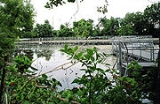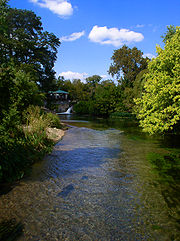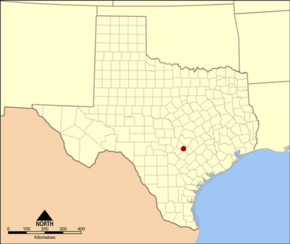
San Marcos Springs
Encyclopedia
San Marcos Springs is the second largest natural cluster of springs
in Texas
. The springs are located in the city of San Marcos, Texas
, about 30 miles (48 km) southwest of Austin
and 46 miles (74 km) northeast of San Antonio
.

 The San Marcos Springs is an area of artesian
The San Marcos Springs is an area of artesian
outflow from the Edwards Aquifer
along the Balcones Escarpment
. More than 200 springs flow from three large fissures and other smaller openings in the rock. The springs provide most of the water for the San Marcos River
, which flows southward from the springs' location.
The springs have never been known to stop flowing. The average flow is 152 ft³/s (4,300 liters/s); the lowest recorded flow of 46 ft³/s (1,302 L/s) occurred in 1956.
In 1849, former Republic of Texas
vice president Edward Burleson
built a dam just downstream from the springs; the resulting lake, known as Spring Lake, inundated the springs.
believe that the San Marcos Springs area may be the oldest continually inhabited site in North America. Excavations at this location uncovered Paleo Indian
artifacts dating back as much as 12,000 years. The Tonkawa
farmed this area more than 800 years ago; they called the springs Canocanayesatetlo ("warm water"), a reference to the springs' relatively warm 72 °F (22 °C) year-round temperature.
The first Europeans to see the springs were probably members of the Espinosa-Olivares-Aguirre expedition of 1709. Later, the Spanish
mission San Xavier and the failed settlement of San Marcos de Neve were situated there. White American
s began settling the area in 1835, and the springs became a major stop on the Chisholm Trail
. From 1928 until 1996, a resort and amusement park known as Aquarena Springs
was located at the site. Texas State University-San Marcos purchased the surrounding area in 1994, and the site is now known as Aquarena Center.
is found only west of the Balcones Fault
, which feature runs through San Marcos Springs.
San Marcos Springs is home to several endangered species
, including the Fountain darter
, the Texas Blind Salamander
, the San Marcos Salamander, the San Marcos Gambusia
, and Texas Wild Rice
. Federal requirements to protect the species' environment, and the resulting demands those requirements place on water from the Edwards Aquifer, have led to several legal and political battles throughout the region.
Spring (hydrosphere)
A spring—also known as a rising or resurgence—is a component of the hydrosphere. Specifically, it is any natural situation where water flows to the surface of the earth from underground...
in Texas
Texas
Texas is the second largest U.S. state by both area and population, and the largest state by area in the contiguous United States.The name, based on the Caddo word "Tejas" meaning "friends" or "allies", was applied by the Spanish to the Caddo themselves and to the region of their settlement in...
. The springs are located in the city of San Marcos, Texas
San Marcos, Texas
San Marcos is a city in the U.S. state of Texas, and is the seat of Hays County. Located within the metropolitan area, the city is located on the Interstate 35 corridor—between Austin and San Antonio....
, about 30 miles (48 km) southwest of Austin
Austin, Texas
Austin is the capital city of the U.S. state of :Texas and the seat of Travis County. Located in Central Texas on the eastern edge of the American Southwest, it is the fourth-largest city in Texas and the 14th most populous city in the United States. It was the third-fastest-growing large city in...
and 46 miles (74 km) northeast of San Antonio
San Antonio, Texas
San Antonio is the seventh-largest city in the United States of America and the second-largest city within the state of Texas, with a population of 1.33 million. Located in the American Southwest and the south–central part of Texas, the city serves as the seat of Bexar County. In 2011,...
.
Geology


Artesian aquifer
An artesian aquifer is a confined aquifer containing groundwater under positive pressure. This causes the water level in a well to rise to a point where hydrostatic equilibrium has been reached. This type of well is called an artesian well...
outflow from the Edwards Aquifer
Edwards Aquifer
The Edwards Aquifer is one of the most prolific artesian aquifers in the world. Located on the eastern edge of Edwards Plateau in the U.S. state of Texas, it discharges about of water a year and directly serves about two million people...
along the Balcones Escarpment
Balcones Fault
The Balcones Fault Zone is a tensional structural system in Texas that runs approximately from the southwest part of the state near Del Rio to the north central region near Waco along Interstate 35. The Balcones Fault zone is made up of many smaller features, including normal faults, grabens, and...
. More than 200 springs flow from three large fissures and other smaller openings in the rock. The springs provide most of the water for the San Marcos River
San Marcos River
The San Marcos River rises from the San Marcos Springs, the location of Aquarena Springs, in San Marcos, Texas. The springs are home to several threatened or endangered species, including the Texas Blind Salamander, Fountain Darter, and Texas Wild Rice...
, which flows southward from the springs' location.
The springs have never been known to stop flowing. The average flow is 152 ft³/s (4,300 liters/s); the lowest recorded flow of 46 ft³/s (1,302 L/s) occurred in 1956.
In 1849, former Republic of Texas
Republic of Texas
The Republic of Texas was an independent nation in North America, bordering the United States and Mexico, that existed from 1836 to 1846.Formed as a break-away republic from Mexico by the Texas Revolution, the state claimed borders that encompassed an area that included all of the present U.S...
vice president Edward Burleson
Edward Burleson
Edward Burleson was a soldier, general, and statesman in the state of Missouri, the Republic of Texas, and later the U.S. state of Texas....
built a dam just downstream from the springs; the resulting lake, known as Spring Lake, inundated the springs.
History
ArchaeologistsArchaeology
Archaeology, or archeology , is the study of human society, primarily through the recovery and analysis of the material culture and environmental data that they have left behind, which includes artifacts, architecture, biofacts and cultural landscapes...
believe that the San Marcos Springs area may be the oldest continually inhabited site in North America. Excavations at this location uncovered Paleo Indian
Paleo Indians
Paleo-Indians or Paleoamericans is a classification term given to the first peoples who entered, and subsequently inhabited, the American continent during the final glacial episodes of the late Pleistocene period...
artifacts dating back as much as 12,000 years. The Tonkawa
Tonkawa
The Tickanwa•tic Tribe , better known as the Tonkawa , are a Native American people indigenous to present-day Oklahoma and Texas. They once spoke the now-extinct Tonkawa language believed to have been a language isolate not related to any other indigenous tongues...
farmed this area more than 800 years ago; they called the springs Canocanayesatetlo ("warm water"), a reference to the springs' relatively warm 72 °F (22 °C) year-round temperature.
The first Europeans to see the springs were probably members of the Espinosa-Olivares-Aguirre expedition of 1709. Later, the Spanish
Spain
Spain , officially the Kingdom of Spain languages]] under the European Charter for Regional or Minority Languages. In each of these, Spain's official name is as follows:;;;;;;), is a country and member state of the European Union located in southwestern Europe on the Iberian Peninsula...
mission San Xavier and the failed settlement of San Marcos de Neve were situated there. White American
White American
White Americans are people of the United States who are considered or consider themselves White. The United States Census Bureau defines White people as those "having origins in any of the original peoples of Europe, the Middle East, or North Africa...
s began settling the area in 1835, and the springs became a major stop on the Chisholm Trail
Chisholm Trail
The Chisholm Trail was a trail used in the late 19th century to drive cattle overland from ranches in Texas to Kansas railheads. The portion of the trail marked by Jesse Chisholm went from his southern trading post near the Red River, to his northern trading post near Kansas City, Kansas...
. From 1928 until 1996, a resort and amusement park known as Aquarena Springs
Aquarena Springs
Aquarena Center is an educational center in San Marcos, Texas dedicated to the preservation of the unique archeological and biological resources of Spring Lake. It is managed on behalf of Texas State University–San Marcos by the Texas River Systems Institute located in the Texas Rivers Center...
was located at the site. Texas State University-San Marcos purchased the surrounding area in 1994, and the site is now known as Aquarena Center.
Flora and fauna
This region is a dividing line for certain species occurrence. For example, the iconic California Fan Palm, Washingtonia filiferaWashingtonia filifera
Washingtonia filifera , with the common names California Fan Palm , Desert Fan Palm, Cotton palm, and Arizona Fan Palm. It is a palm native to southwestern North America between an elevation range of , at seeps, desert bajadas, and springs where underground water is continuously available...
is found only west of the Balcones Fault
Balcones Fault
The Balcones Fault Zone is a tensional structural system in Texas that runs approximately from the southwest part of the state near Del Rio to the north central region near Waco along Interstate 35. The Balcones Fault zone is made up of many smaller features, including normal faults, grabens, and...
, which feature runs through San Marcos Springs.
San Marcos Springs is home to several endangered species
Endangered Species Act
The Endangered Species Act of 1973 is one of the dozens of United States environmental laws passed in the 1970s. Signed into law by President Richard Nixon on December 28, 1973, it was designed to protect critically imperiled species from extinction as a "consequence of economic growth and...
, including the Fountain darter
Fountain darter
The fountain darter is a small freshwater fish found in the headwaters of only two rivers in Texas: the Comal River and the San Marcos River. It is generally smaller than 3 cm long and feeds on small invertebrates...
, the Texas Blind Salamander
Texas Blind Salamander
The Texas Blind Salamander ', is a rare cave-dwelling troglobite amphibian native to San Marcos, Hays County, Texas, specifically the San Marcos Pool of the Edwards Aquifer. The salamander has blood-red external gills for absorbing oxygen from the water. The salamander's mature length is...
, the San Marcos Salamander, the San Marcos Gambusia
San Marcos gambusia
The San Marcos gambusia is an endangered species of fish, found only in the San Marcos Springs of Central Texas. The fish has not been seen since 1983, so it may be extinct.- Description :...
, and Texas Wild Rice
Wild rice
Wild rice is four species of grasses forming the genus Zizania, and the grain which can be harvested from them. The grain was historically gathered and eaten in both North America and China...
. Federal requirements to protect the species' environment, and the resulting demands those requirements place on water from the Edwards Aquifer, have led to several legal and political battles throughout the region.
External links
- Take Me To The River webcast from the Texas Parks and Wildlife Department

